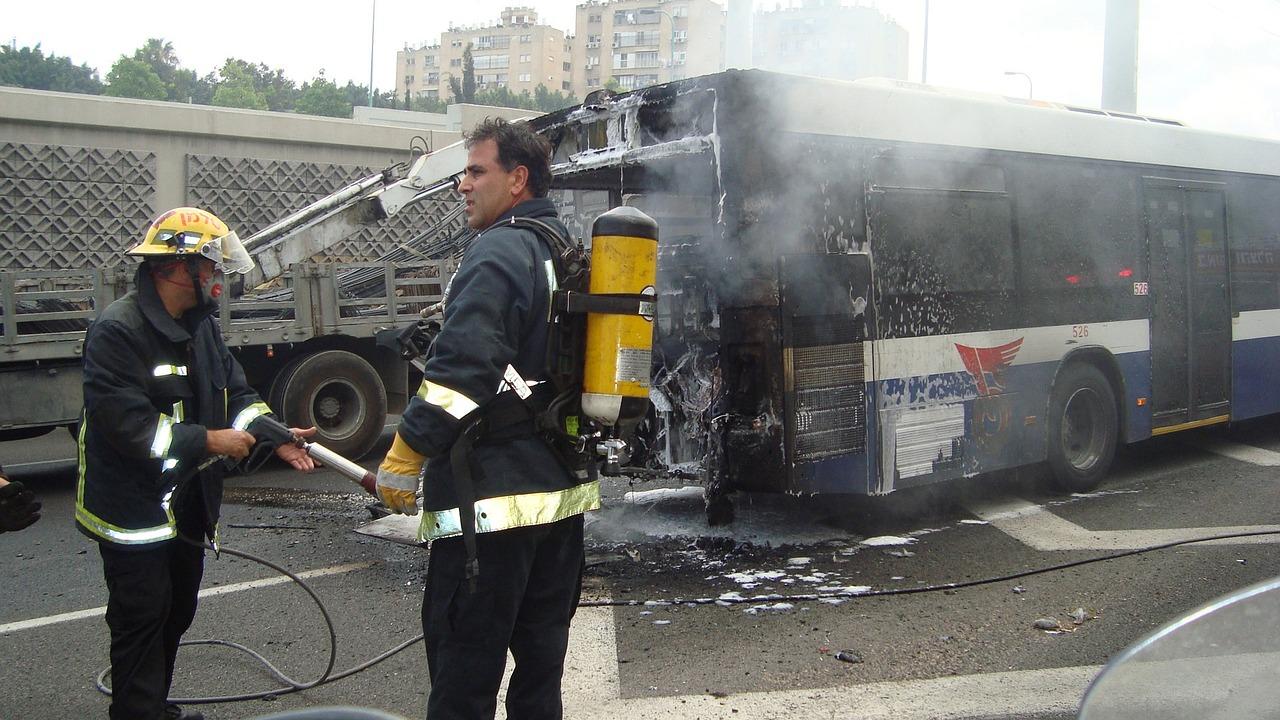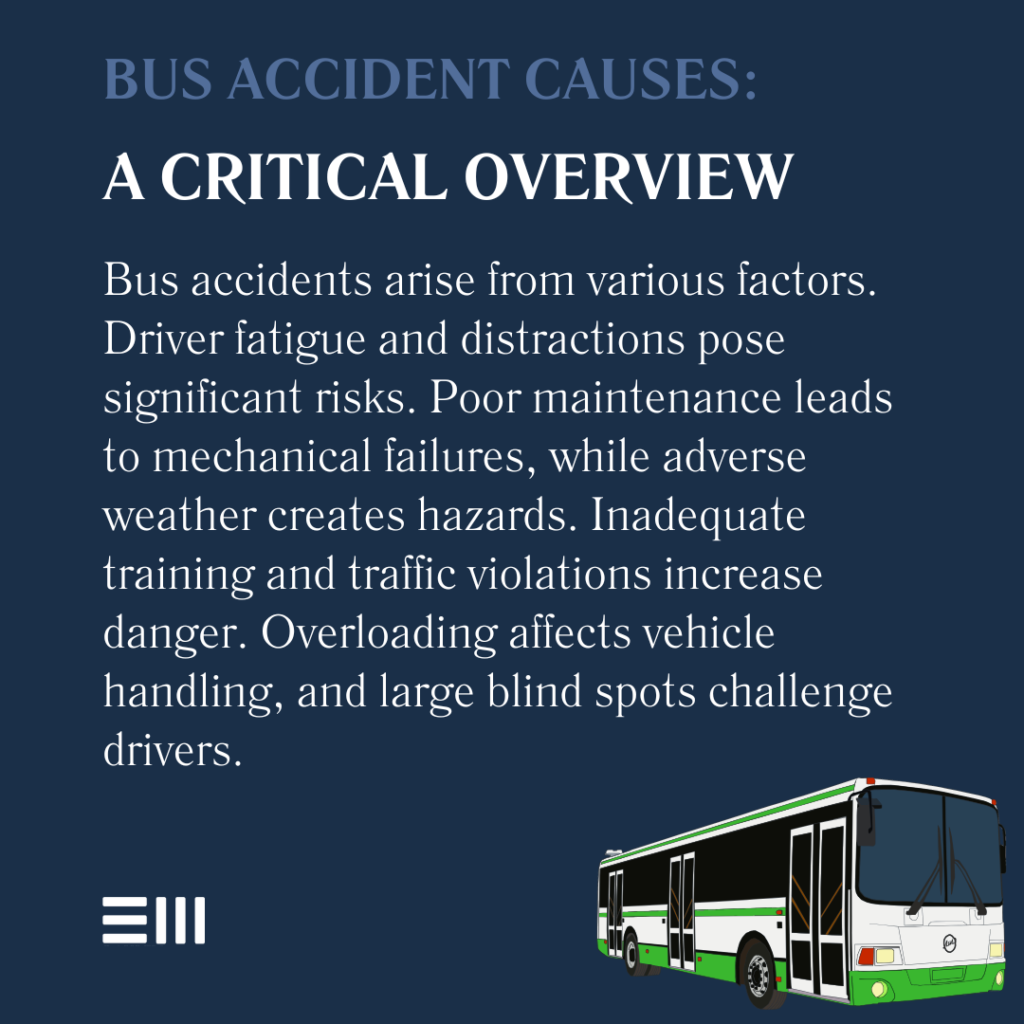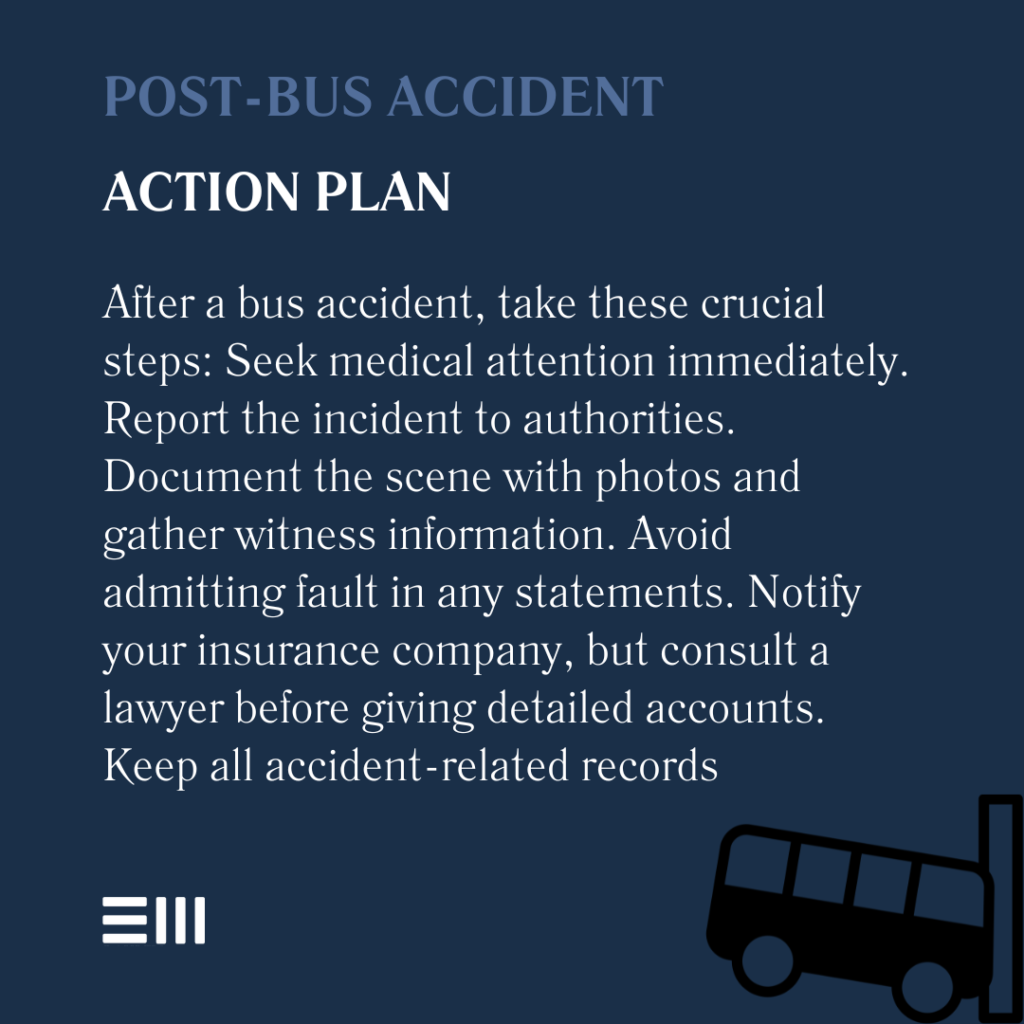
Every day, millions of Americans rely on buses for transportation, whether for work, school, or leisure.
However, the National Highway Traffic Safety Administration reports that over 60,000 buses are involved in crashes annually, resulting in thousands of injuries and fatalities.
These sobering statistics underscore the importance of understanding bus accident causes and the legal options available to victims.
Common Causes of Bus Accidents
Bus accidents can stem from various factors, often intertwining to create dangerous situations on the road.
Understanding these causes is crucial for prevention and determining liability in the event of an accident.
- Driver Fatigue: Long hours behind the wheel can lead to decreased alertness and slower reaction times. The Federal Motor Carrier Safety Administration (FMCSA) regulates driving hours, but violations still occur, putting passengers and other road users at risk.
- Distracted Driving: With the proliferation of smartphones and in-vehicle technology, distracted driving has become a leading cause of accidents. Bus drivers juggling multiple tasks, from route navigation to passenger communication, face increased risks of losing focus on the road.
- Poor Vehicle Maintenance: Neglecting regular inspections and maintenance can result in mechanical failures. Issues like faulty brakes, worn tires, or malfunctioning signals can lead to catastrophic accidents, especially given the size and weight of buses.
- Adverse Weather Conditions: Rain, snow, ice, and fog create hazardous driving conditions. Bus drivers must adapt their driving to these conditions, but sometimes fail to do so adequately, leading to accidents.
- Improper Training: Insufficient training in handling large vehicles, navigating diverse road conditions, or managing passenger safety can contribute to accidents. Bus companies have a responsibility to ensure their drivers are properly trained and certified.
- Traffic Violations: Speeding, running red lights, or failing to yield right-of-way are common traffic violations that can result in bus accidents. The consequences of these violations are often magnified due to the size and passenger capacity of buses.
- Overloading: Exceeding a bus’s weight capacity can affect its handling, braking distance, and overall stability. This is particularly problematic in long-distance or charter buses where luggage and cargo are significant factors.
- Blind Spots: Buses have large blind spots, making it challenging for drivers to see other vehicles, pedestrians, or obstacles. Failure to check these blind spots thoroughly before maneuvering can lead to collisions.
Understanding these common causes is the first step in preventing bus accidents and determining liability when they occur. However, when accidents do happen, it’s essential to be aware of the legal remedies available to victims.

Legal Remedies for Bus Accident Victims
When individuals are injured or suffer losses due to a bus accident, they have several legal options to seek compensation and justice.
The specific remedies available can vary depending on the circumstances of the accident and the parties involved.
- Personal Injury Lawsuits: Victims of bus accidents may file personal injury lawsuits against responsible parties. These lawsuits seek compensation for medical expenses, lost wages, pain and suffering, and other damages resulting from the accident.
- Wrongful Death Claims: In cases where a bus accident results in fatalities, surviving family members may pursue wrongful death claims. These legal actions aim to compensate families for the loss of their loved ones, including funeral expenses and loss of financial support.
- Claims Against Government Entities: If the accident involves a public transit bus, victims may need to file claims against government entities. These claims often have specific procedures and shorter deadlines, making it crucial to act quickly and follow precise legal protocols.
- Insurance Claims: Pursuing insurance claims is often the first step in seeking compensation. This can involve dealing with the bus company’s insurance, personal auto insurance, or, in some cases, uninsured motorist coverage.
- Class Action Lawsuits: In cases of large-scale accidents affecting multiple victims, class action lawsuits may be appropriate. These allow a group of plaintiffs to collectively seek damages against the responsible parties.
- Workers’ Compensation Claims: If the accident occurred while the victim was on the job (e.g., a bus driver or passenger traveling for work), workers’ compensation claims might be applicable, providing benefits regardless of fault.
- Product Liability Claims: When accidents result from defective bus parts or equipment, victims may have grounds for product liability claims against manufacturers or distributors of the faulty components.
- Negligence Claims: Many bus accident cases revolve around proving negligence. This could involve the bus driver, the bus company, other motorists, or even entities responsible for road maintenance.
Navigating these legal remedies can be complex, especially when dealing with the aftermath of a traumatic accident.
Determining Liability in Bus Accidents
Establishing liability is a critical step in pursuing legal remedies after a bus accident. Multiple parties may bear responsibility, and thorough investigation is often necessary to identify all potentially liable entities.
- Bus Drivers: Bus drivers may be held liable if their negligence or misconduct contributed to the accident. This could include instances of distracted driving, speeding, or operating under the influence.
- Bus Companies: Companies that own and operate buses are responsible for maintaining their vehicles, properly training their drivers, and ensuring compliance with safety regulations. Failure to meet these obligations can result in liability.
- Manufacturers: If a defective part or design flaw contributed to the accident, the bus or part manufacturer could be held responsible through product liability laws.
- Government Entities: In cases involving public transportation, local or state governments may be liable, particularly if poor road maintenance or inadequate signage played a role in the accident.
- Other Motorists: Sometimes, the actions of other drivers on the road contribute to bus accidents. In such cases, these motorists may bear full or partial liability for the resulting damages.
- Maintenance Contractors: Third-party companies responsible for bus maintenance and repairs could be liable if their negligence in servicing the vehicle led to mechanical failures causing the accident.
Determining liability often requires extensive investigation, including analysis of police reports, witness statements, vehicle maintenance records, and sometimes accident reconstruction experts.
Steps to Take After a Bus Accident
Knowing what to do in the immediate aftermath of a bus accident can significantly impact the strength of any subsequent legal claim.
Here are essential steps for victims to consider:
Seek Medical Attention
Health and safety should be the top priority. Even if injuries seem minor, getting a medical evaluation is crucial, as some injuries may not be immediately apparent.
Report the Accident
Ensure that the accident is reported to the appropriate authorities. This typically involves calling the police and filing an official report.
Document the Scene
If possible, take photos of the accident scene, including vehicle positions, road conditions, and any visible injuries. This evidence can be valuable for insurance claims and legal proceedings.
Gather Witness Information
Collect contact information from witnesses willing to provide statements about what they observed. Their accounts can be crucial in establishing the facts of the accident.
Avoid Admitting Fault
Be cautious about making statements that could be interpreted as admitting fault. Stick to factual information when discussing the accident with authorities or other parties involved.
Notify Your Insurance Company
Report the accident to your insurance company, but do not provide detailed statements until you have consulted with a legal professional.
Keep Records
Maintain a file of all accident-related documents, including medical records, receipts for accident-related expenses, and correspondence with insurance companies or other parties.
Consult With a Legal Professional
Consider seeking advice from an attorney experienced in bus accident cases. They can provide guidance on protecting your rights and pursuing appropriate legal remedies.
Taking these steps can help protect your interests and strengthen any potential legal claims arising from the bus accident.

Frequently Asked Questions About Alabama Bus Accidents
Understanding the legal landscape surrounding bus accidents can be challenging.
Here are answers to some commonly asked questions to help clarify key points and concerns.
What’s the Statute of Limitations for Bus Accident Claims in Alabama?
In Alabama, the statute of limitations for personal injury claims, including those arising from bus accidents, is generally two years from the date of the accident.
However, if the claim is against a government entity, there may be shorter notice requirements. It’s crucial to act promptly to preserve your right to seek compensation.
How Is Compensation Calculated in Bus Accident Cases?
Compensation in bus accident cases typically includes economic damages (such as medical expenses and lost wages) and non-economic damages (like pain and suffering).
The specific amount depends on factors including the severity of injuries, long-term impact on the victim’s life, and the degree of fault attributed to different parties.
Can I Still Seek Compensation if I Was Partially at Fault for the Accident?
Alabama follows a contributory negligence rule, which means that if you are found to be even slightly at fault for the accident, you may be barred from recovering compensation.
This makes it especially important to have skilled legal representation to argue your case effectively.
What if the Bus Accident Involved a School Bus?
Accidents involving school buses may involve different legal considerations, particularly if public school districts operate them.
These cases often involve claims against government entities, which have specific procedural requirements and limitations on liability.
Fight Harder, Fight Smarter
Bus accidents can have devastating consequences, impacting victims’ lives in profound ways. If you or a loved one has been involved in a bus accident in Alabama, you don’t have to face the aftermath alone.
At Baxley Maniscalco, we understand the complexities of bus accident cases and are committed to fighting for the rights of accident victims.
Don’t let the statute of limitations or procedural complexities jeopardize your right to seek justice.
Contact Baxley Maniscalco today for a free consultation. Let us put our expertise to work for you, ensuring that your voice is heard and your rights are protected.
Can't find what you're looking for? Search our site below.










